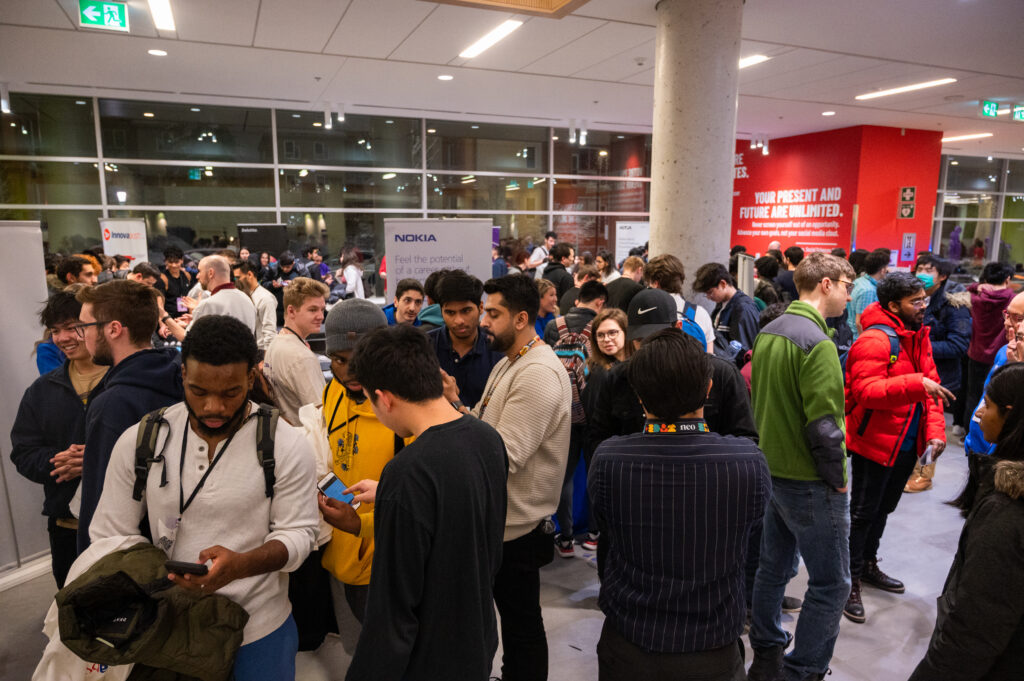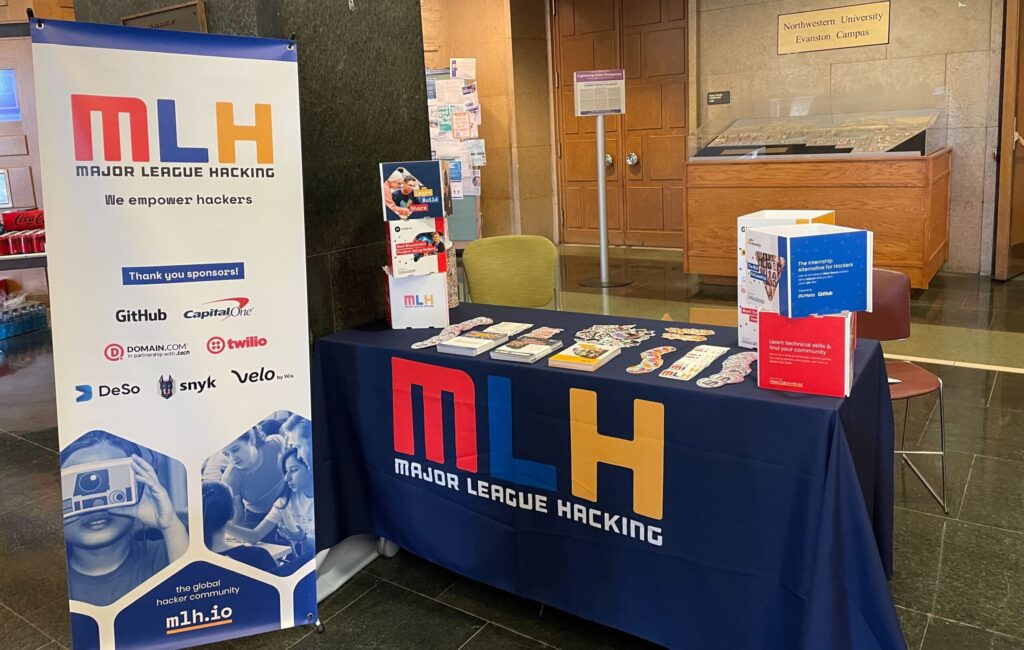Purchasing a booth at a hackathon or any in-person event can be expensive. However, having a booth where attendees can find you is critical to helping your team achieve your goals. That’s why we’ve put together this comprehensive list of pro tips to help you make the most of your next hackathon booth.
What staff members should we send to a hackathon?
The staff you send to a hackathon should reflect the goals you’re trying to achieve. If you want people to use your API, send a Developer Evangelist. If you want to hire people, send a Recruiter. In both cases, we also recommend sending an Engineer. It’s important in the hackathon environment that you have at least some technical staff that can support the developers. Your staffing roster should have at least two individuals that bring different expertise to the table, creating two different opportunities to engage with attendees. For all but the largest hackathons, two people are sufficient for staffing the entire event.
When you’re recruiting team members to staff a hackathon, try to look for people who are really going to be excited to be there regardless of their seniority or job role. For example, a staff member who is more junior but really excited to be there might have a greater impact than a senior manager who would rather be doing something else with their weekend.
How can I maximize the performance of my staff?
Once you’ve selected your staffing roster for an event, it’s up to you to make sure they’re prepared to show up and be successful. Role-playing exercises are one of the best ways to train event staff. Prepare common questions and attendee interactions, and have your team practice their response. Role-playing can help eliminate the awkwardness, and help your team get the most out of every developer interaction at hackathons and other events.
It’s critical that every staff member is friendly, welcoming, and proactive. Hackathons are a unique environment where every attendee is there to do something – whether it’s learning new skills or building a project. You’ll find that attendees are often excited and passionate about the projects they are working on at the event. Simple outgoing questions can turn an otherwise mundane transactional exchange into a meaningful, memorable, and in-depth conversation.
If an attendee comes up to your booth, below are some ways to start a conversation with them:
- “Hey, how’s it going? My name is Jon, and I’m the Co-Founder of Major League Hacking. What’s your name? What brings you to this event?”
- “What are you working on this weekend? How did you come up with the idea? That’s so cool! What part are you most excited about?”
- “What are you hoping to learn this weekend? Which workshops are you excited about?”
When are the most important times to staff a booth at a hackathon?
The best times to be at your booth during a hackathon are right after the opening ceremony, meal times, and whenever there is a special event taking place like a raffle or snacks. During times when there is a lot of foot traffic, stand in front of your booth to talk to attendees. It can be off-putting for attendees to approach a booth where the event representative is sitting behind the table on their laptop or phone.
Standing in front immediately presents a more welcoming and inviting way to encourage attendees to approach your booth. It also prevents people from walking up to your booth and taking promotional materials like swag and then leaving without any further engagement, which can be counterproductive to your event goals.
How do I know if my booth strategy is working?
Start by writing down your event goals, and then build some success metrics off of it. To evaluate whether your booth strategy is working, we can use quantitative and qualitative metrics. When you’re at an in-person event, how someone feels about your company is equally as important as what they get from it.
Below are some questions to ask your team to help you collect qualitative metrics through your developer interactions:
- Are people interested in your presence at the event? Do they ask questions and engage with your staff?
- Do they understand why you’re at the event?
- Do they understand what your company or product does?
Below are some examples of quantitative metrics your team can collect:
- # of email captures
- # of swag items distributed
- # of projects using your product, or # of resumes collected.
How much should I be investing in the booth design?
Hackathons can often be a scrappier environment. Compared to most conferences or trade shows your team might attend, you do not need a huge flashy booth to achieve your goals. Most teams can typically get by with a branded tablecloth, swag, and a simple banner that catches the eye of attendees. If you want to showcase your product, you may want to bring a monitor or informational pamphlets. The important thing to remember is that you don’t need any crazy gimmicks to be successful, just keep it simple and fun.
How important is it to have swag at my booth?
More important than the booth design at a hackathon is your swag strategy. Make sure your team has a combination of low and high-value swag on hand. In the context of a hackathon, high-value swag is something big and tangible someone can take home like a t-shirt, water bottle, or blanket. Low-value swag items are those that you can produce affordably in greater quantities like stickers, keychains, and USB keys. Distribute your low-value swag to anyone that comes up to your table and says hi, and reserve the high-value swag for the attendees who are the most engaged with your team. For example, you might give a t-shirt to any outstanding candidate who approaches your booth to express interest in working for your company and gives you their resume.
You can be strategic with your promotional materials as well. Don’t pull all of your flyers out on the table at the beginning of the event and put yourself at risk of running out too soon. Attendees will take anything you leave on the table, and that includes anything you leave overnight. Anything that is valuable should be stored in your hotel room or at least out of sight at times where you don’t want people taking it, like overnight.
What’s the best way to collect attendee information?
Some hackathons do offer the ability to collect lead opt-ins during registration. However, if you don’t have that option as part of your package, I generally recommend setting up a simple form that people can fill out with their email. If people need a little motivation to sign up, try offering them a piece of low-value swag in exchange for filling out your form.
Your form should be very simple and ask attendees for their name, email, school, and maybe the name of their hackathon project. If your team is at a big hackathon, you could put a flyer on the table with a short URL that folks can easily fill out on their form while they wait to speak with your booth staff. This can be a great way to find out who you are engaging with and follow up with them post-event on a more personal basis, such as writing about their projects on your blog or talking to them about job opportunities.
How can I make my booth stand out?
If you’re at the hackathon to generate user sign-ups and evangelize your product, it can be nice to have different booth-side demos going on throughout the event. You could even do mini-workshops or activities to draw people to your table. For example, Bloomberg used to bring their Terminal to hackathons, drawing in huge crowds of students curious about what it could do. Another way of drawing in students to your booth is by offering unique swag. For example, Capital One’s cereal was a major draw for attendees to talk to them about job opportunities. A good booth has one thing that differentiates itself from the competition.
There’s a lot of thought and strategy that goes into planning a successful hackathon booth. If you’re interested in getting more hackathon advice, Major League Hacking can help you get your platform in front of tens of thousands of early career technologists. We help our customers achieve large-scale developer adoption with minimal time investment from your team. If you’re interested in learning more, visit our website.

